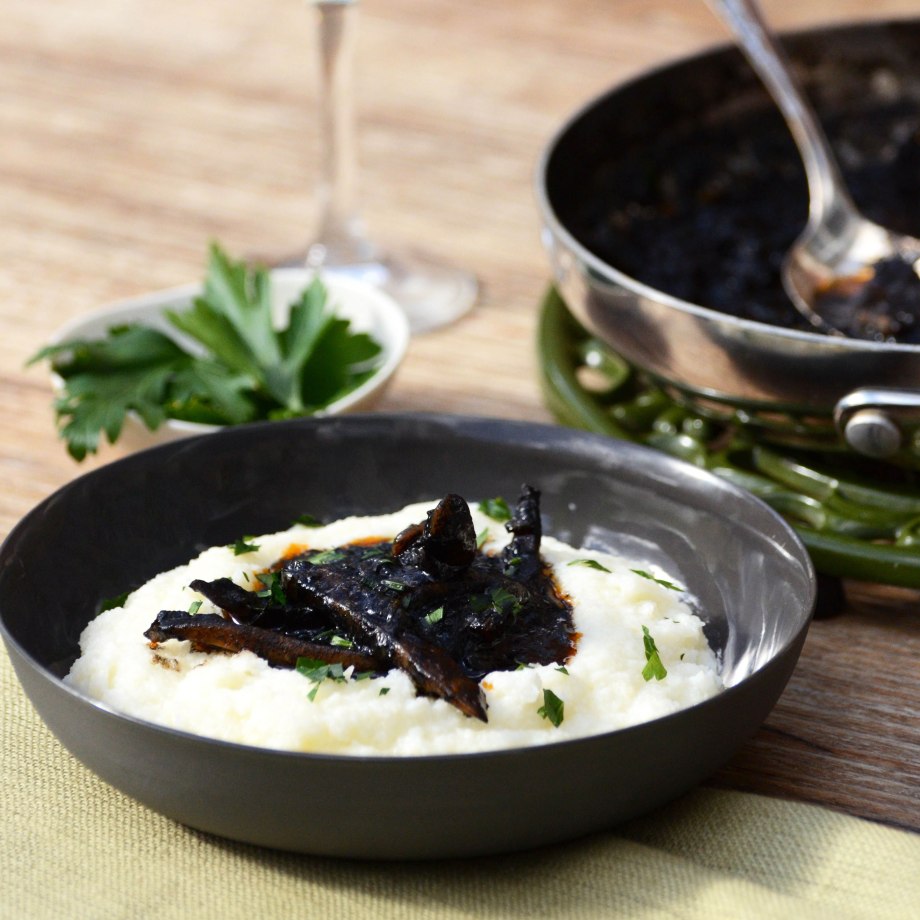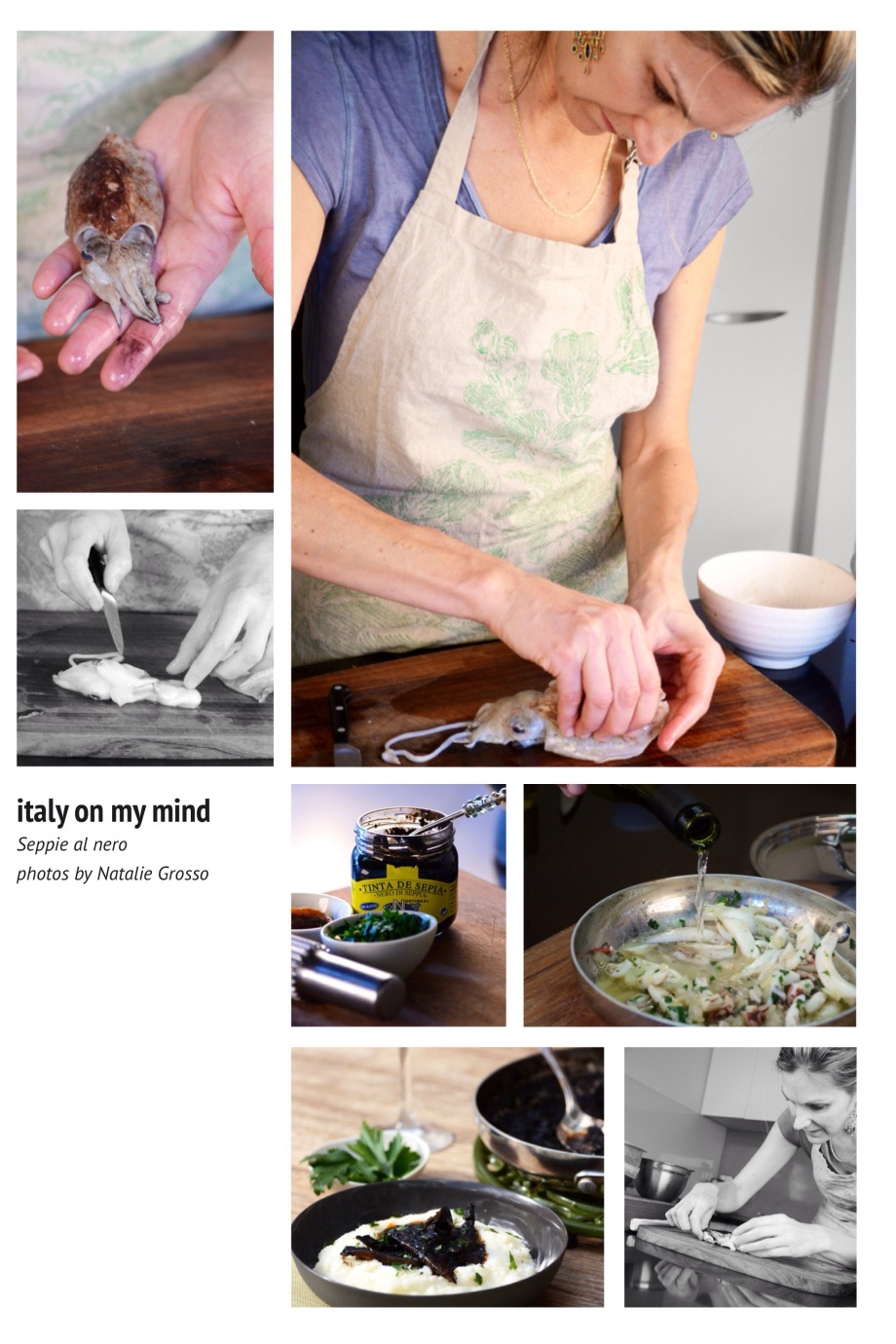Whenever I am at a restaurant and see a dish with squid ink in it, I invariably order it. I can’t resist the inky look of the meal that emerges from the kitchen.
Here are a couple of interesting inky facts:
1. If we want to be correct, the ink is cephalopod ink, which includes the ink of squid, octopus and cuttlefish.
2. The ink is released by the cephalopod to create a “smokescreen” in the water and escape attack
3. Not all cephalopod ink is black – octopus ink is black, cuttlefish ink is brown and squid ink is blue-black
4. The italian word for cuttlefish is seppia (plural-seppie) and the ink it releases is brown. This is the origin of the reddish brown colour “sepia” used in the art world.
Speaking of seppie, I cooked them a few weeks ago and Natalie Grosso of OAK art & design took the photos as I prepared and served the dish.
I love cooking with and eating squid and cuttlefish – blame my father, who was equally obsessed and taught me how to clean them (link for cleaning cuttlefish from the Sydney Seafood School is here). Your local fishmonger can also clean them for you – especially if there aren’t many other customers around (and you smile sweetly). For this dish I used squid ink in a jar (you can also buy it in small sachets) as you can’t always rely on the ink sac to not be broken when you buy the fish. If you have never eaten a dish with squid ink, it doesn’t have a strong taste. It is subtle and works beautifully in a risotto or in pasta. The ink is mainly used for its glossy inky colour. Contrary to what you may think, it does not stain bench tops or cloth – it washes out easily with water. So don’t be scared to use it! This dish is seriously good. it reminds me of Venezia. The cuttlefish is cooked for over an hour, so it is tender and the sauce is a savoury delight, although not very fishy. I served the dish on soft white polenta, but you could easily just mop it up with fresh crusty bread. Serve it with a crisp white wine, I am drinking Coriole Fiano from South Australia at the moment. Buon appetito!
Seppie al nero con polenta
600g (1.3 lbs) cuttlefish (weight before cleaning)
1 small brown onion, finely diced
1 clove garlic, crushed
2 anchovies
2 tablespoons parsley leaves, chopped
1/2 glass dry white wine
2 teaspoons tomato paste
1 teaspoon squid ink in a jar or the ink sacs from the cuttlefish
2 – 3 tablespoons olive oil, for cooking
salt and pepper
Polenta
150g (5.3 oz) polenta (yellow or white)
750ml (1.5 pints) boiling water (plus extra if needed)
50g (1.8 oz) butter
10g (0.4 oz) parmigiano cheese (approx), grated
salt to taste
Start off by cleaning the cuttlefish (or buy them already cleaned). Slice the cleaned body into diagonal strips (approximately as wide as your finger) and keep as many of the tentacles as you can (if you have small cuttlefish they may be very small so you should discard them). Set aside.
In a small to medium frypan, heat the olive oil at medium heat and cook the onions until they are soft and starting to colour. Add the garlic and anchovies, breaking the anchovies with a wooden spoon and cook for a minute or two until fragrant. Increase the heat and add the cuttlefish and half the parsley. Cook for around ten minutes at medium to high heat, stirring frequently until the liquid that the cuttlefish releases evaporates. Add the wine, reduce the heat and cover. Simmer for around 20 minutes, stirring occasionally. Next add the tomato paste and ink, stirring it in and continue cooking, covered until fork tender (about 40 minutes, but don’t be afraid to cook longer if it is still tough). Add salt and pepper to taste.
Serve on polenta and garnish with remaining parsley.
To make the polenta, boil the water in a medium saucepan. When it is a rolling boil, add the polenta in a slow steady stream, stirring all the while with a whisk. When you have added all the polenta, whisk briskly for a few more minutes to make sure you don’t have any lumps. Exchange the whisk for a wooden spoon and stir for another minute. Check the polenta every 3-4 minutes and give it another good stir. You might need to add some water if it looks too dry. Continue to do this for about 20-25 minutes. The grains of polenta should cook and soften and there should be no lumps.The polenta is ready when it comes away from the sides of the pan. Stir in the butter and cheese and add salt to taste. Place on individual plates and make a well in the centre to place the sauce.
Linked recipes:
Marinated octopus
Stuffed squid





Beautiful photographs and a great looking dish! I love the Spanish version of this dish, described as “en su tinta”, in his ink, with a lovely black, garlic sauce that has a velvet texture. The cuttlefish is very quickly cooked and soft, the inky black against the white flesh. Mmmmm
LikeLike
Thanks Jo. That sounds fantastic, love the fact that it is cooked so quickly – I think the Italians and Spanish do dishes with squid so well.
LikeLike
I’m totally with you… food with squid ink is great! Beautiful recipe, I’d like to try making it…. gorgeous photos!
LikeLike
Thank you very much !
LikeLike
This is a dish I know my husband would love. The only cuttlefish I can buy have already been cleaned and frozen. I’ll have to see if I can find the jarred ink.
LikeLike
that is good that you don’t have to go through the cleaning – I am sure you would be able to buy ink sachets on line if you can’t find them locally.
LikeLike
I am also a big fan and your photos look wonderful, I just want it to jump out and be on my table!
LikeLike
thank you! it seems that lots of Italians and Spaniards “get” squid ink dishes, glad you do too.
LikeLike
[…] with onion and anchovies. Another typical dish is squid ink risotto (risotto al nero di seppia) or sauted squid with polenta (seppie in nero con polenta). Squid ink is so common in Venice you can buy it in the local store. […]
LikeLike
[…] sort med blekket fra blekkspruten (risotto al nero di seppia) eller sautert blekksprut med polenta (seppie in nero con polenta). Nettopp blekksprut med polenta spiste jeg på Osteria da Alberto, og jeg har aldri spist […]
LikeLike